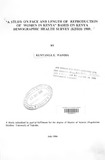| dc.description.abstract | This study estimates and examines the two end points of reproductive life of women in
Kenya. These are the starting and stopping of childbearing. Of more specific interest in the study
is the period of time taken by a woman in reproduction also referred to as the length of
reproduction, and the pace or tempo of reproducing. These two important measures of human
reproductive behaviour greatly determine fertility. The understanding of factors that affect these
said measures is a good step towards general understanding of fertility phenomenon it self.
The study utilises data from the Kenya Demographic and Health Survey (KDHS) of 1989.
The methodologies of Suchindran and Home (1984) and Home (1985),and Sivarmurthy's life
table technique are used to estimate the mean age at first birth, mean age at last birth, mean
reproductive span, and mean inter-birth spacing. The methods have not been extensively tested
but from the results it can be said that they are reliable in that the results obtained from their
use conform to those found by the previous studies. The difference in results for the above two
methods can also be said to be very small and not really of any significance. Multivariate
regression analysis was also used to examine the relationship between selected variables and the
ages at first birth and last birth.
Based on study, the national mean age at first birth is low at about 20 years while the
mean age at last birth is about 40 years. The total fertility rate obtained from unadjusted age
specific fertility rates is 6.5. This leaves a reproductive span of 20 years and a national mean
interbirth spacing of close to 3 years. The findings further reveal that there exists regional, and
socio-cultural, socioeconomic sub-group variations in the estimated indices country wide. The
differences in these indices are also seen to cause significant impact in fertility. Education is the
most important variable in determining the extent of ages at first birth, ages at last birth, and
generally the spacing of children. Contraception, which is said to be responsible for fertility
reduction in the country could be said to achieve this through lengthening of the childbearing
interval.
The policy implications that have been arrived at from the study are such as to improve
women education especially for the rural ones, availing more employment opportunities for
women and developing a policy that discourages early marriages. | en |

